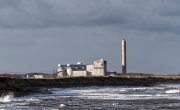Biomass 'dirtier' than coal, according to new report
 Burning whole trees in power stations can be dirtier than coal, according to a new report by the RSPB, Friends of the Earth and Greenpeace.
Burning whole trees in power stations can be dirtier than coal, according to a new report by the RSPB, Friends of the Earth and Greenpeace.
‘Dirtier than Coal’, released on Monday (12 November), uses government data to show that burning whole trees to generate electricity can be worse for the climate than coal: generating power from typical conifer trees results in 49 per cent more emissions than burning coal, it claims. The report refutes the argument that biomass is ‘carbon neutral’ because trees capture carbon as they re-grow, pointing out that it can take decades or centuries for new trees to offset carbon emissions from burning whole trees.
It follows a series of announcements from major coal power stations, including Drax and Eggborough, that outline intentions to switch over from burning coal to burning wood. As a result, the three organisations are calling on government to cancel plans to subsidise burning whole trees in coal power stations and new ‘biomass only’ power plants. Instead, they have called for policy to focus on building a small-scale bioenergy sector based on sustainable UK feedstocks, including wood waste and arisings from forestry, as well as continued investment in renewable energy such as solar, wind and wave power.
‘End the fiction that burning wood is carbon free’
Harry Huyton, RSPB Head of Climate Policy, explained: “When trees are burnt in power stations, CO2 comes out of the chimney, just like it does when you burn coal. The difference is that the wood is less energy dense and is wetter than coal, so it takes a lot more energy to harvest, transport, process, and finally burn it.
“Government has justified burning trees in power stations by claiming the chimney emissions are offset by the carbon that the forest takes in when it re-grows after being harvested, but this is misleading. It can take decades, if not centuries, for the trees to recapture that carbon, leaving us with more emissions in the atmosphere now – when we least need it.
“Worse, the idea that there is enough wood to keep our lights [on] without endangering the world’s forests is equally misguided. If government subsidies go ahead, this report shows that we will be burning 30 million tonnes of wood each year. That’s six times the total UK harvest. This massive demand for wood will result in traditional industries that depend on wood – for furniture and building materials, for example – losing out and having to use other materials like plastic and concrete, which are worse for the environment, instead.”
Doug Parr, Policy Director from Greenpeace UK, added: “It’s time to end the fiction that burning wood is carbon free. If we don’t get the arithmetic right on the real impacts of biomass energy, our carbon budgets will be more like carbon fraud. Meanwhile opportunities in UK for delivering sustainable energy and job-creation are going begging.”
Drax
The UK’s largest power source, Drax, has announced it will convert three of its six boilers to run off biomass, requiring seven million tonnes of plant material a year (compared to the 2.75 million tonnes of wood that were burnt in all UK power stations combined in 2011/12, according to Ofgem). Drax intends to import 90 per cent of its biomass, and claims it will largely fall within the Department of Energy and Climate Change’s (DECC) proposed emissions limits for biomass of 285 grammes of CO2 per kilowatt hour (gCO2/kWh).
Drax’s figures are based on the standard method of reporting that does not count biogenic carbon, as it is commonly argued that this will eventually be cancelled out by re-growing forest. ‘Dirtier than Coal’ questions this approach, however, noting that it can take decades or centuries to repay the ‘carbon debt’. According to Princeton researcher Timothy Searchinger, over a 20-year period, emissions from power stations burning trees from conifer plantations would be 1,879 gCO2/kWh, 80 per cent greater than coal. After 100 years, this falls to 902 gCO2/kWh, which is 14 per cent better than coal, but far above the 285 gCO2/kWH limit for biomass plants.
Subsidies
DECC’s ‘Renewables Roadmap’ estimates that by 2020, biomass could potentially provide between 26 and 42 per cent of renewable energy in the UK, and government expects to provide a subsidy for biomass of between £442 million and £736 million, though it is still working out its long-term policy.
‘Dirtier than coal’ follows on from calls from the furniture industry to end the biomass subsidy for large, industrial-scale biomass plants. The Furniture Industry Resource Association (FIRA) and the British Furniture Confederation (BFC) claims such subsidies put their industry at risk, which in turn means less CO2 remains stored in wood furniture. Like the environmental groups, FIRA and the BFC have called for a focus on smaller-scale biomass plants that burn waste wood.
Read more about biomass energy.






